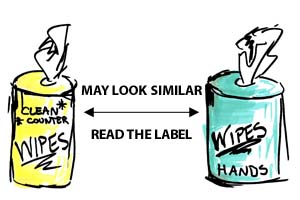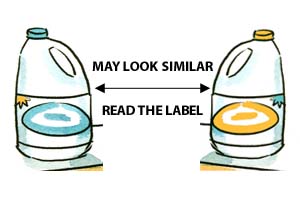Antimicrobial products kill or slow the spread of microorganisms. Microorganisms include bacteria, viruses, protozoans, and fungi such as mold and mildew.1 You may find antimicrobial products in your home, workplace, or school.
The U.S. Environmental Protection Agency (EPA) regulates antimicrobial
products as pesticides, and the U.S. Food and Drug Administration (FDA)
regulates antimicrobial products as drugs/antiseptics. As pesticides, antimicrobial
products are used on objects such as countertops, toys, grocery
carts, and hospital equipment. As antiseptics, antimicrobial products are
used to treat or prevent diseases on people, pets, and other living things.
If a product shows "EPA" anywhere on the label, you know it's a pesticide and NOT meant for use on the body.
This fact sheet will focus on antimicrobials used as pesticides.
If a product label claims to kill, control, repel, mitigate or reduce a pest, it is a pesticide regulated by the U.S. EPA.2 When manufacturers make this kind of claim on the label, they must also include:
- application instructions that are effective at killing or controlling the pest, and
- first aid instructions, in case of accidental exposure.
Pesticides
Used on surfaces, non-living things
Example: wipes for the kitchen or bathroom
Regulated by the U.S. EPA
Drugs & Antiseptics
Used in or on living things
Example: hand-sanitizing wipes
Regulated by the U.S. FDA
Bleach is a common name for products that contain sodium hypochlorite. Bleach may be
a
pesticide, a cleaner,
or both.
Bleach as a pesticide
As a pesticide, bleach is used to disinfect surfaces.
The label will include specific directions
about how to use the product effectively. There
will be an EPA registration number on the container.
Bleach as a cleaner
As a general-purpose cleaner or whitening
agent, bleach is used on household surfaces
and laundry. In this case, it is not acting as a
pesticide so it does not require EPA registration.3,4
Pest-killing instructions will not be
included on the label.
What types of antimicrobial pesticides are there?
There are two general categories for antimicrobial pesticides: those that address
microbes in public health
settings,
and those that do not. "Public health products" are designed to handle infectious microbes. See Table 1.
Table 1. Sites of application for antimicrobial pesticides1
| Non-public health settings |
Public health settings |
| Microbes that may cause objects to spoil or rot |
Microbes that may cause people to get sick |
- cooling towers
- fuel
- wood textiles
- paint
- paper products
|
- bathrooms
- kitchens
- homes
- hospitals
- restaurants
|
There are three types of public health antimicrobials: sterilizers, disinfectants, and sanitizers. See Table 2.
Sanitizers are the weakest public-health antimicrobials. They reduce bacteria
on surfaces.1 Some sanitizers may be
used on food-contact surfaces
such
as
countertops, cutting boards, or children's high chairs. The label will indicate
how a sanitizer can be used. Some sanitizers can be used only for non-food
contact surfaces like toilet bowls and carpets, or air.5,6
Disinfectants kill or prevent the growth of bacteria and fungi. Some disinfectants
target specific viruses.5,6,7
Disinfectants that kill microbes are
called
microbicides,
but if they only stop microbial growth, without killing the microbe,
they are called microbistats.9 Disinfectants are the preferred public-health
antimicrobial for common surfaces in medical settings. Disinfectants are also
used in residential settings. Different products purify swimming pools and
disinfect household surfaces such as linens, toilets, and bathtubs. Whether
disinfectants are used in medical or residentials settings, or elsewhere, they
may not be used on surfaces that come in contact with food.
Sterilizers are the strongest type of public health antimicrobial product. In
addition
to bacteria, algae, and fungi, they also control hard-to-kill spores.5
Many
sterilizers
are restricted-use pesticides. These require applicator training and certification.
Sterilizers are used in medical and research settings when the presence of
microbes must be prevented as much as possible. In addition to chemical sterilizers,
high-pressure steam and ovens are also used to sterilize items.5
Table 2. Three main types of public health antimicrobial pesticides*
|
Sanitizer |
Disinfectant |
Sterilizer |
| Effective against |
99.9%
|
100%
- bacteria
- fungi
- certain viruses
|
100%
- bacteria
- fungi
- viruses
- spores
|
| Time required for effectiveness |
30 seconds - 5 minutes |
Generally 10 minutes |
Variable |
| Locations / Uses |
Household surfaces
Food contact surfaces |
Household surfaces
Medical settings |
Medical instruments
Research supplies |
| Effect |
Limited microbicide |
Microbicide
Irreversible microbistat |
Microbicide |
| Formulations |
Sprays, liquids, gels, granules, etc. |
Sprays, liquids, gels, granules, etc. |
Liquid, gases |
|
*This table contains generalized
information. Always read the product
label
to determine where
and how a product should be used.5,7,10,11
|
- Always follow the label
directions. The
"Directions for Use" are
specific, and the product may not
work if you don't follow them.
- Never mix different antimicrobial products.
- Most antimicrobial products take time to work. Read the label to find out how long the product
must
remain
in
contact with the surface in order to sanitize, disinfect or sterilize it.10
- Dirt, food, slime, and other particles may reduce the effectiveness of antimicrobial
products.10
- Take steps to reduce your exposure to antimicrobial pesticides. Some products can be harmful
when
touched or
inhaled.
For more detailed information about antimicrobials please visit the referenced resources below, call NPIC at 800-858-7378, Monday - Friday, 8:00am-12:00pm PT (11:00am-3:00pm Eastern Time), or email us at npic@oregonstate.edu.
NPIC aims to use the best scientific resources available at the time fact sheets are written. NPIC does not have the resources to keep all of its fact sheets entirely up to date. All NPIC documents have dates that indicate when the material was updated. For more information about how NPIC selects scientific resources for inclusion in fact sheets, please see our page here: npic.orst.edu/factsheets/review.html.







